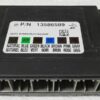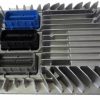Are you battling frustrating starting issues, unexpected stalling, or a persistent check engine light? A faulty Fuel Pump Control Module (FPCM) is often the culprit, leaving you stranded and stressed. Get your vehicle back to its reliable self with our pre-programmed FPCM, the definitive solution for restoring proper fuel delivery and engine performance. We take the guesswork out of the repair by flashing this module with the latest GM software, perfectly matched to your vehicle’s specific VIN. This isn’t just a part; it’s a direct path to a smooth-running, dependable vehicle.
Common Symptoms of a Failing FPCM & Your Direct-Fit Solution
If your vehicle is experiencing any of the following, a failing module is the likely cause. This part is designed to be the complete fix for these issues:
- Engine cranks but refuses to start
- Vehicle stalls unexpectedly, especially under load
- Hesitation or sputtering during acceleration
- Rough or unstable idling
- Reduced engine power and poor fuel economy
- Check Engine Light with codes like P069E, P0230, or U0109
Installing this pre-programmed 2014 Impala fuel pump control module eliminates the need for expensive dealership programming, saving you time and money and getting you back on the road faster.
Features & Benefits
- ✔ Programmed to Your VIN: Arrives ready for installation with no additional programming required. Just plug it in and turn the key.
- ✔ Latest GM Software: Flashed with the newest vehicle-specific updates to ensure optimal performance, fuel efficiency, and longevity.
- ✔ Direct-Fit Replacement: Engineered to match OEM specifications for a perfect fit and seamless integration with your vehicle’s systems. Compatible with part numbers 22874299 and 22874300.
- ✔ Restores Engine Performance: Corrects fuel pressure and delivery issues, leading to smoother starts, stable idling, and responsive acceleration.
- ✔ Purchase with Confidence: This unit is backed by our one-year replacement warranty.
An Expert’s Note on VIN Programming
In modern vehicles like your Impala, the FPCM isn’t just a simple switch; it’s a computer that constantly communicates with the main Engine Control Module (ECM). VIN programming is critical because it loads the exact software parameters your specific vehicle needs to operate correctly. A generic, non-programmed module can cause communication errors, poor performance, or even fail to work at all. By programming it to your VIN before shipping, we ensure this module speaks the exact same digital language as the rest of your car, guaranteeing a successful and lasting repair.
Don’t let a faulty FPCM dictate your schedule. This expertly programmed 2014 Impala fuel pump control module is the most reliable and convenient solution to restore your vehicle’s health. By providing your VIN upon purchase, you are ensuring a hassle-free installation and a return to the dependable performance you expect from your car. This is the smart fix for a critical problem.
Frequently Asked Questions
How do I provide my VIN?
After you complete your purchase, simply send us a message with your vehicle’s 17-digit Vehicle Identification Number (VIN). We cannot ship the part until we receive this information, as it is required for programming.
Where can I find my VIN?
Your VIN is typically located on a metal plate on the driver’s side dashboard (visible through the windshield), on the driver’s side door jamb sticker, or on your vehicle’s registration and insurance documents.
Is any additional programming needed after installation?
No. This module is a true plug-and-play solution. Because we program it to your specific VIN before it ships, you will not need to visit a dealer or mechanic for any further computer work. Just install the part, and you’re ready to go.
Will this fit models other than the 2014 Impala?
Yes. This module fits a wide range of GM vehicles, including the Camaro, Cruze, Sonic, Volt, XTS, Verano, and more. Please check the detailed fitment list in our description to confirm compatibility with your specific make, model, and year.
What makes this better than a used or non-programmed part?
A used module may have existing faults or outdated software. A non-programmed new part requires a trip to a dealership and expensive programming fees. Our 2014 Impala fuel pump control module provides the best of both worlds: a reliable component with the latest software, ready for immediate installation out of the box.


